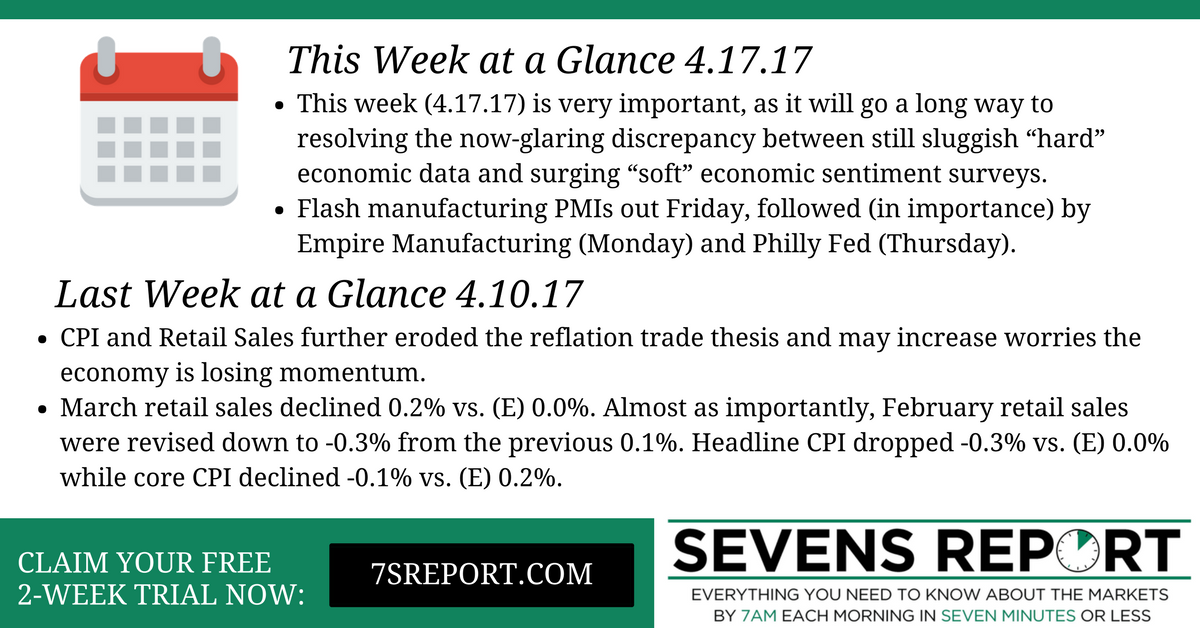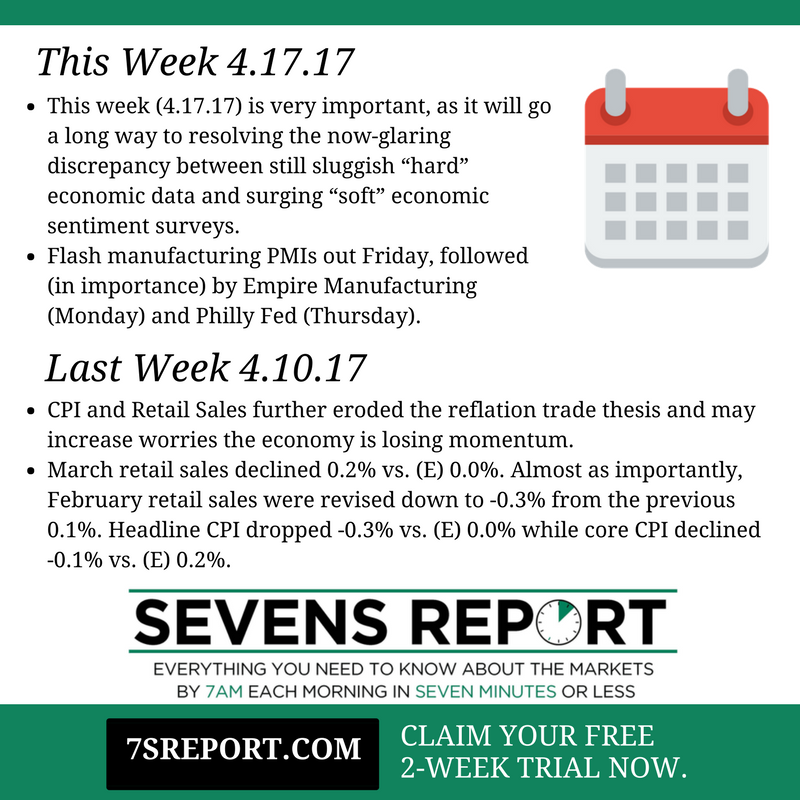Last Week and This Week in Economics, April 17, 2017

Last Week in Economics – 4.10.17
The two important economic numbers came out Friday when markets were closed, so they didn’t receive much attention, although they should have. Both numbers (CPI and Retail Sales) further eroded the reflation trade thesis and will increase worries the economy is losing momentum.
Starting with retail sales, the headline on this number was plain ugly. March retail sales declined 0.2% vs. (E) 0.0%. Almost as importantly, February retail sales were revised down to -0.3% from the previous 0.1%. As longer-term readers know, we generally disregard the headline and instead look at the “control” group retail sales, which is retail sales ex autos, gasoline and building materials. That control group gives us a better read on truly discretionary spending.
Here the numbers are a bit better. Control retail sales rose 0.5% in March vs. (E) 0.3%, but February was revised lower from 0.1% to -0.2%. So, considering revisions, the March number wasn’t a beat.
Bottom line, this number is not good for stocks. Consumer spending was the engine powering the Q3/Q4 2016 economic acceleration, and the sluggishness in consumer spending now is extending beyond what we would consider normal slack following a big acceleration. These are not the kind of numbers we would see if a bigger economic acceleration is looming.
Turning to CPI, it also undermined the “reflation” trade in the near term. Headline CPI dropped -0.3% vs. (E) 0.0% while core CPI declined -0.1% vs. (E) 0.2%. Additionally, the year-over-year core CPI reading dipped from 2.3% in Feb. to 2.0% in March. This soft CPI reading isn’t a damning number, and clearly the trend of inflation is higher. Yet markets need modestly higher inflation and better growth to power stocks higher, and last week’s numbers did not suggest that’s happening.
Bottom line, this week now is very important, as it will go a long way to resolving the now-glaring discrepancy between still sluggish “hard” economic data and surging “soft” economic sentiment surveys.
Finally, to make this a bit more real, Friday’s numbers resulted in the GDP Now for Q1 dropping to just 0.5%. That type of economic growth simply cannot support stocks at these levels, and as such we should expect Friday’s data to further pressure bond yields and the dollar, which will increase stock headwinds.
This Week in Economics – 4.17.17
This week is important for markets because we will get a much more definitive answer to the question of whether the pace of economic growth is losing momentum. How that question is answered will go a long way to determining whether the S&P 500 takes out the March low of 2322, or if stocks can bounce.
To that point, the most important economic releases this week all contain March data, and the most important report will be the flash manufacturing PMIs out Friday, followed (in importance) by Empire Manufacturing (today) and Philly Fed (Thursday). The reason those numbers are so important is because it’s April data, so they will give us the most current view of the pace of economic activity in the US. If they further imply there is a loss of momentum, that will further undermine the reflation trade and hit stocks. Conversely, markets need strong data this week to help reinvigorate the reflation trade thesis.
Looking beyond those March data points, the next most important report this week is March Industrial Production. This number is important because a wide gulf still exists between “soft” sentiment -based data, and “hard” economic numbers. Industrial production is the next opportunity for some of that “hard” economic data to move higher and begin to close that gap.
Bottom line, we’re coming to a head on the debate over soft vs. hard economic data, and whether the recent economic acceleration can last. While there aren’t a lot of numbers this week, what data we do get is important to resolving that debate… and that will move markets.
The Sevens Report is the daily market cheat sheet our subscribers use to keep up on markets, seize opportunities, avoid risks and get more assets.








